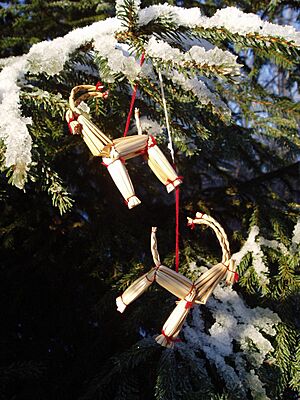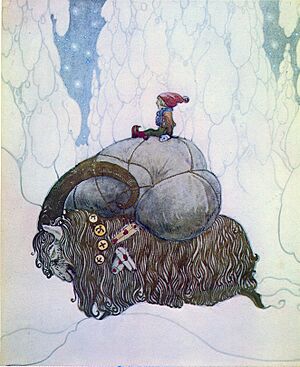Julebukking facts for kids


Julebukking (pronounced YOO-leh-book-ing) is a fun Christmas tradition from Scandinavia. It's also known as Gå julebukk, which means "go Christmas goat." This custom is a bit like modern-day Halloween trick-or-treating.
Between Christmas and New Year's Day, people dress up in masks and costumes. These people are called Julebukkers. They go from house to house in their neighbourhood. When they visit a home, the people inside try to guess who is under the disguise.
Sometimes, Julebukkers sing Christmas songs at each house. After they sing, they often get candy or other treats. In another part of the tradition, at least one person from the visited house joins the Julebukkers. Then, the whole group continues to the next home together. Julebukkers often try to change their voices and how they move. This makes it harder for neighbors to figure out who they are. It is also common for homes to offer the Julebukkers holiday treats and drinks. Once everyone knows who is who, and the snacks are eaten, the Julebukkers move on to the next house.
The History of Julebukking
The Julebukking tradition is very old. It started even before Christianity came to Scandinavia. In its earliest form, it was a pagan ritual. Many people believe it began in Norway. Long ago, pagans there worshiped Thor, a god who rode in a chariot pulled by two goats.
During the Yule holiday, people would dress up in goatskins. They would carry a goat head and go from house to house. This was a way to honor Thor and his goats.
The Yule Goat Symbol
Later, Christian missionaries changed the tradition. They removed its pagan meaning. The Yule Goat became an important Christmas symbol. It is one of the oldest Christmas traditions in Scandinavia.
Today, the Yule Goat is a common Christmas decoration. It is often made from straw. You might see it with a red ribbon around its neck. Many families place it under their Christmas tree.
Julebukking in America
German and Scandinavian immigrants brought Julebukking to America. While the tradition is not as common in Europe now, you can still find it. It is sometimes seen in rural American towns. These towns often have many people of Scandinavian descent. Places like Petersburg, Alaska, Ketchikan, Alaska, and Rushford, Minnesota have kept the tradition alive.

